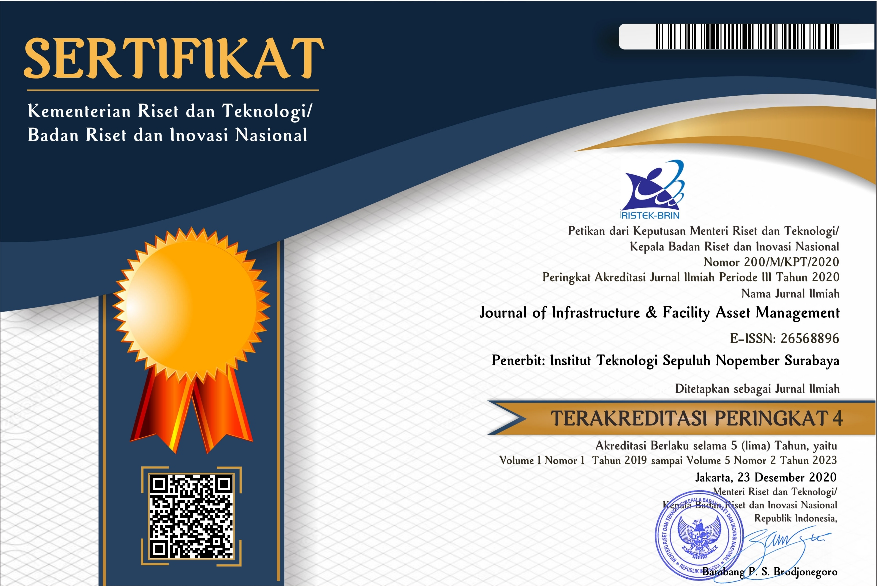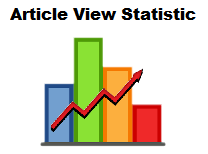Implementation of Risk Management in Property Projects
Abstract
Abilitythe company's organization to manage risk is very dependent on the characteristics of the project and must take into account vulnerabilities during risk identification and assessment. In the property development process, vulnerability is a system characteristic that will create the possibility of damage, danger and failure. Vulnerability is a system that functions as a control and manageability. Risk is a function of threat values, consequences, and vulnerability. Risk is a function of threat values, consequences, and vulnerability. The purpose of risk management is to create a level of protection that alleviates vulnerability to threats and potential consequences, thereby reducing risk to an acceptable level. The implementation of risk management must be an integral part of the implementation of the company's management system. The risk management process is one step that can be taken to create continuous improvement.
The stages carried out in this study include: identification of the source of risk, the stage of identification of risk factors, the stage of identification of the level of hazard, the stage of identification of the level of vulnerability, the stage of identification of the level of capacity, the stage of risk analysis, and the determination of priority risks. Conceptually, the method proposed in this study refers to the key steps of risk management which include identification, qualitative risk analysis in the property development process. Data collection was carried out through interviews and filling out questionnaires by resource persons involved in property development in the tourism area of Nusa Dua Resort ITDC Bali Province. Risk factors that are given priority for ongoing mitigation and monitoring are: interest rate risk and inflation, risk of development cost analysis, risk of final design, risk of land maturation and risk of development financing targets. It can be concluded that overall the level of risk in developing the Nusa Dua resort area is acceptable (IPR <0.24) and the development of the Nusa Dua Resort area is indeed feasible to be developed or built.
Full Text:
PDFReferences
AS/NZS 4360: 1999 (1999). Australian / New Zealand Standards on Risk Management, Australian Standards and New Zealand Standards.
Asia's New Real Estate Investment Trust (2007).www.asianewsinvesment.op
BTDC (2015). Annual Report. PT. Bali Tourism Development. Nusa Dua-Bali
Brodjonegoro, P.S, (1991). Guidance Regarding Theory and Application of The Analytic Hierarchy Process Model. Sapta Utama. Jakarta.
Cadman, D. & Topping, D.(1995). Property Development.E & FN Sponge: London
Cadman, D. & Austin-Crowe, L. (1993). Property Development, Spon. London
COSO (2004). Committee of Sponsoring Organizations of The Treadway Commission. Enterprise Risk Management Framework.Copyright © 2004 by the Committee of Sponsoring Organizations of the Treadway Commission. All rights reserved.
Cooper, D.F., Macdonald D.H., & Chapman, C.B. (1987). Risk Analysis for Large Projects. Jhon Wiley & Sons Ltd., Norwich.
DeLeon J.C.V. (2006). “Vulnerability. A conceptual and methodological review”. Source Studies of the University: Research, Counsel. Education. Publication Series of UNU-EHS. No 4/2006. http://www.ehs.unu.edu/file/get/3904. Germany.
Darmawi, H. (2008). Risk Management. Earth Literacy. Jakarta.
Dikmen, I. & Birgonul, T. (2006). “An analytical process-based model for risk opportunity assessment of international construction projects”. Canadian Journal of Civil Engineering (in press).
Djojosoedarsono, S. (2003). Principles of Risk Management and Insurance. Salemba Empat. Jakarta
Ezell, B., Farr, J. & Wiese, I. (2000). “Infrastructure risk analysis model”. Journal of Infrastructure Sytem, 6 (3), 114-117.
Flanangan, R. & Norman, G. (1993). Risk Management and Construction. Blackwell Scientific. Oxford UK.
Gehner, et al (2006). “Risk Management in the Dutch Real Estate Development Sector: a Survey”. Proceedings of the 6th International postgraduate research conference in the built and human environment. University of Salford, UK. pp. 541-552.
Gehner (2008). Knowingly Taking Risk - Investment Decision Making in Real Estate Development. Eburon
Geltner, D.M. and Miller, N.G. (2000). Commercial Real Estate Analysis and Investments. Mason. South Carolina
Godfrey (1996). Construction Research Industry and Information Association (CIRIA).
Graeme, N. & Mark, S. (2001). “Assessment of the importance of property development risk factors”. Pacific Rim Property Research Journal Vol.12 No.1.
ISO 31000:2009 (2009). International Organization for Standard 31000:2009. Risk Management Principles and Guidelines. Geneva.
Kerzner, H. (1998). Project Management: A System Approach to a Planning, Scheduling and Controlling. JhonWiley & Sons. New York.
Khalafallah, A., Taha, M., & El-Said, M. (2005). “Estimating cost contingencies of residential buildings projects using belief networks”. Journal of the Faculty of Engineering. Cairo University, Cairo. Egypt.
Miles, M., Haney, D. & Berens, G. (2000). Real Estate Development: Principles and Process. Urban Land Institute: Washington DC.
Ozcan (2008). A Generic Risk and Vulnerability Assessment Framework for International Construction Projects. A Thesis Submitted to The Graduate School of Natural and Applied Sciences. Middle East Technical University. Ankara.
Indonesian Property Study Center (2005). Journal of Property XI Edition, January 2005.
Patria (2006). Risk management modeling on the Build-Operate-Transfer project. Master's Thesis in Civil Engineering. Indonesian Islamic University. Yogyakarta.
Peiser, R.B. & Frej, A.B. (2003). Professional Real Estate Development. The ULI Guide to the Business. Urban Land Institute. Washington DC.
Peiser, R. (1984). “Risk analysis in land development”. Journal of the American Real Estate and Urban Economics Association, Vol. 12, pp. 12-29.
PMI (2000). A guide to the project management body of knowledge. Project Management Institute. Newton Square.
PMBOK (2004). A guide to the project management body of knowledge. Project Management Institute. Newton Square.
Rafitas, A.B. (2005). Tips for Business Success in Property Brokerage Business in Jakarta. Jakarta
Saaty, T.L. (1986). The Analytic Hierarchy Process. RWS Publications. Pittburgs.
Saaty, T.L. (1998). “Fundamentals of Analytic Network Process.” Proceedings of the 5th International Conference on Analytic Hierarchy Process, Kobe, 2023.
Sarewitz, D., Pielke, Jr.R. & Keykhah, M. (2003). “Vulnerability and risk: Some thoughts from a political and policy perspective”. Risk Analysis, 23 (4), 805-10.
Salzmann, A. & Mohamed, S. (1999). “Risk Identification Frameworks for International BOOT Projects”. In (ed) Ogunlana S. Profitable Partnering in Construction Procurement, CIB W92 Proceedings Publication 224, pp. 475-485, ISBN 0-419-24760-2.
Sugiyono (2009). Qualitative Quantitative Research Methods and Research Development. CV Alfabeta. Bandung.
Suharto, I. (2001). Project Management from Conceptual to Operational. Erlangga Publisher. Jakarta.
Thomas, A. (2008). Analysis of the formulation of property management business strategies in entering the market: Case study at PT. Petrimeq. Thesis. Indonesian University. Jakarta.
Valsamakis, A.C., Vivian, R.W. & Du Toit, G.S. (2000). Risk Management. 2nd ed. Heinemann. Sandton.
Wiegelmann, T. (2012). Risk Management in Real Estate Development Industry. Submitted in Total Fulfillment of the Requirements of the Degree of: Doctor of Philosophy. Institute of Sustainable Development & Architecture. Bond University. Robina. Queensland.
Whipple, T. (1998). “Evaluating Development Projects”. The Valuer (Oct): 158-170.
Wurtzebach, C.H., Miles, M.E. & Cannon, S.E. (1995). Modern Real Estate. 5th Edition. Wiley & Sons Publishers. New York.
Zhang, H. (2007). “A redefinition of the project risk process: using vulnerability to open up the event link link". International Journal of Project Management, 25 (7).
DOI: http://dx.doi.org/10.12962%2Fjifam.v3i1.13467
Refbacks
- There are currently no refbacks.
Visitor :
Flag Counter

Journal Of Infrastructure & Facility Asset Management by Institut Teknologi Sepuluh Nopember is licensed under a Creative Commons Attribution-ShareAlike 4.0 International License.





